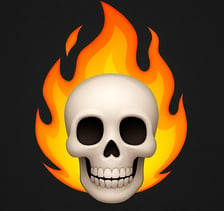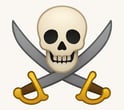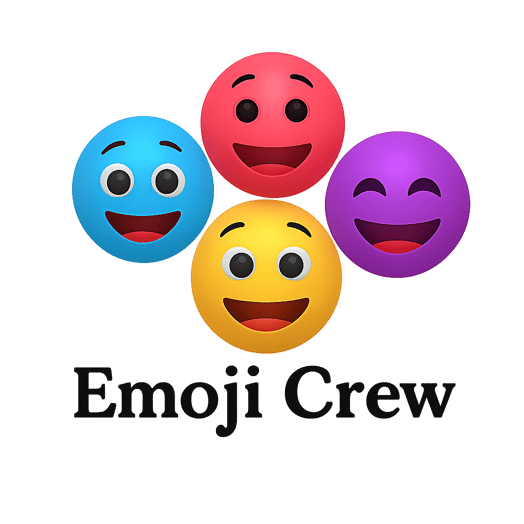Skull Emoji Explained 💀: From Dark Humor to Pop Culture Symbol
5/8/20244 min read
The Skull emoji is an emoji that has multiple meanings and can be used in different ways. Lets explore its meanings, how its used, and interesting facts about it.
The Skull emoji 💀 is used over 300,000 times a day on X did you know that? Many people use this 💀 emoji for different reasons. But what's behind its popularity? Let's dive into the captivating universe of the skull emoji and uncover its secrets.
The Evolution of the Skull Emoji
The Skull emoji for the most part is known for things such as something scary, horror, poison, or death especially around Halloween. The skull emoji (💀) was introduced in 2010 as part of Unicode 6.0, a standardized text encoding system.
The skull emoji makes people people feel fear because a skull represents something dark, or spooky. It's not exactly known when the skull emoji was created but somewhere in late 1990s and 2000s is when emojis in general were first created in Japan. The skull emoji is known for having a dark black eye socket covered with a human skull. It also has a triangle nose and 3 teeth, and has a dark aura. These emojis have different looks on different apps and phone versions like on Apple and Samsung.
Decoding The Meaning of Skull Emoji
The skull emoji is a literal skull and bones and has always represented things like poison, danger, something bad, or better stay away. Even in the workplace companies use the skull and bones symbol to let you know better be careful or stay way. October 31st also known as "Halloween", the skull can be used a lot to celebrate in decorations, costumes, and festivities. In movies the skull and bones has been used to represent horror, screams, and danger.
Over time, the symbol of the skull emoji has changed its meaning overtime on social media due to its popularity. The Skull emoji has also been used to express extreme laughter and jokes. If someone said a joke so funny that you were so full of laughter to the point that you wanted to fall on the floor the skull emoji can now be used in that way. Or you felt something was so funny that you could be "dead" because the jokes were so much. Here is an example:
Ian: I remember you saying there was someone you wanted to take on a date?
Jones: Yeah so who is it?
Ian: Your mama!
Jones: 😡
Ian: Just Kidding 💀
That chat exchange between Ian and Jones is an example of using the emoji to express something being funny or something some said to be funny as an example. Extreme laughter is how many people use the skull emoji as of recent times in modern social media. It hasn't always been the case to use the skull emoji to express laughter. Expressing something to be danger, poison, or forbidden is what the skull emoji was first used for. Here is an example:
Ian: As i was walking home on 5th avenue at 2am, I was hearing weird noises
Jones: Did i hear you just say 5th avenue. Thats dumb, there are coyotes who live among the bushes over there.
Ian: Wow, you saved my life
Ian. Im never walking that route again. Jones: Beware of your surroundings. 💀
As shared before the skull emoji can have multiple meanings but has been mainly known as danger, caution, poison, or horror.
The Skull Emoji used In Pop Culture
Its no secret the skull emoji is used a lot in popular media like movies, tv, advertisements, social media, etc. Many times you have probably seen it hundreds if not thousands of times, without even realizing it. The movie "Pirates of the Caribbean" is an example of how the skull emoji has been in popular movie franchises before its creation in Unicode 6 in 2010. Here is an alternative version of Pirates of the Caribbean skull emoji versus the regular skull emoji, they are very similar:
Culture Differences in Skull Emoji
Western Culture
In western countries like the UK, USA, New Zealand and etc, the skull emoji (💀) is often used to be a symbol of danger, horror, or something scary. It is frequently used in contexts related to Halloween, horror movies, or to indicate something that is metaphorically "dead," like a dead joke or a failed attempt at humor. It can also convey a sense of dark humor or irony. For example, using the skull emoji to express that something is "so funny it killed me" is common use in online conversations.
Eastern Culture
In eastern countries like China, India, Vietnam, and etc, the skull (💀) has a different meaning and understanding. In certain parts of Asia, the skull emoji represents how life can be fragile or finite. It also represents fleeting nature of life drawing from Buddhist traditions. The skull emoji is also used in context of meditation or reflection of life's fragility rather than just horror or death.
Younger Generations
Millennials and Gen Z often use the skull emoji in digital slang. For them, the skull emoji can mean "I'm dead" or "I'm dying," usually in response to something extremely funny. This usage is playful and hyperbolic, indicating strong amusement.
Older Generations
Older adults will see the skull emoji and think of the traditional meanings like death, horror, and something toxic. People who are older have a tendency to not use the skull emoji to laugh out loud and will find it strange to see younger generations use the skull emoji as a way to express laughter.
Conclusion
The skull emoji has been used all over social media and when people text one another. One one hand it can used to express laughter or when something is so funny to the point that that they are "dead". Originally the skull emoji was used to to express danger or something scary. In some cultures like in the east, the skull emoji is seen as important and sacred and using it for jokes is wrong. In other cultures its okay to use the skull emoji for jokes. The skull emoji is used in different ways, styles, age groups etc. This awareness helps in communicating effectively and respectfully across diverse audiences.






Emojis
Discover meanings and trivia about your favorite emojis.
Explore
Connect
emojicrews@gmail.com
Feel the Vibe, Emoji Tribe
© 2024. All rights reserved. / Disclosure: Some of the links in this article may be affiliate links, which can provide compensation to the site at no cost to you if you decide to purchase.
